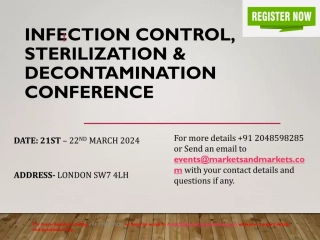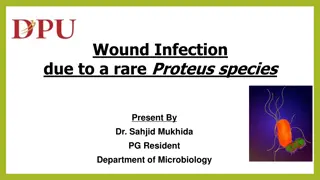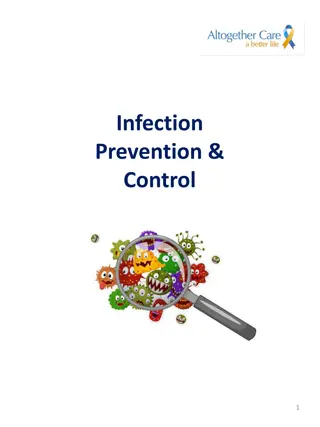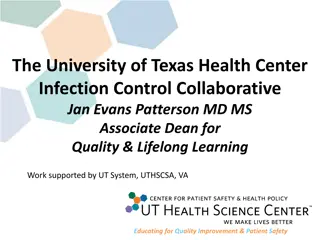Infection Control, Sterilization & Decontamination Event |21st - 22nd March 2024
MarketsandMarkets is pleased to announce its 8th Annual Infection Control, Sterilisation, and Decontamination in Healthcare Conference, which will take place March 21\u201322, 2024, in London, UK. \n\nEnquire Now @ https:\/\/events.marketsandmarkets.com\/infection-control-sterilization-and-decontami
2 views • 5 slides
Infection Control, Sterilization & Decontamination Conference-MarketsandMarkets
MarketsandMarkets is pleased to announce its 8th Annual Infection Control, Sterilisation, and Decontamination in Healthcare Conference, which will take place March 21\u201322, 2024, in London, UK. \n\nEnquire Now @ https:\/\/events.marketsandmarkets.com\/infection-control-sterilization-and-decontami
2 views • 5 slides
Healthcare-Associated Infections Prevention Program: Best Practices
This program by the California Department of Public Health focuses on infection prevention practices during resident positioning and transferring in healthcare settings. It addresses implicit bias, hand hygiene, proper positioning importance, prevention of pressure injuries, and strategies to avoid
0 views • 38 slides
Understanding Infection Prevention & Control Measures
Infection prevention and control measures are essential in healthcare settings and beyond to prevent the transmission of infectious diseases. This article covers the basics of infection prevention, routine practices, additional precautions, and resources for further education on the topic.
4 views • 14 slides
Rapid NHS Response Teams: Enhancing Home Care and Avoiding Hospital Admissions
Somerset Foundation Trust Community offers a comprehensive range of services, including Rapid Response, Urgent Community Response (UCR), and Hospital@Home (H@H). These services aim to provide timely and effective care to individuals in their homes, reducing the need for hospital admissions. Rapid NH
15 views • 6 slides
Understanding Infection: Causes, Signs, and Nursing Management
Learn about the definition of infection, common causes, general and specific signs and symptoms, nursing assessment for foot ulcers and pressure injuries, as well as nursing interventions for infection prevention and management. Dive into the stages of infection, general and specific signs and sympt
0 views • 24 slides
What Are Shingles What Are The Signs & Causes of it
\"Shingles Infection is caused by the varicella-zoster virus. To reduce the risk of this infection, you need to get vaccinated Understanding these causes can help in managing and potentially preventing shingles outbreaks Shingles Infection is caused
0 views • 7 slides
Understanding Canine Viral Infection: A Comprehensive Overview
Canine Viral Infection, caused by canine parvovirus-2, is a highly contagious disease affecting dogs, especially puppies. The infection spreads through fecal-oral route and can lead to severe clinical signs like vomiting, diarrhea, and dehydration. The virus replicates in lymphoid tissues, affecting
0 views • 11 slides
Overview of Ancylostoma duodenale (Hookworm) Infection
Ancylostoma duodenale, a parasitic worm causing Ancylostomiasis, is discussed in this lecture. The infection's distribution, morphology, life cycle, and pathology are detailed, emphasizing the impact on humans. The lifecycle stages, including egg production, larval development, and entry into the hu
0 views • 12 slides
Comprehensive Guide to Infection Prevention and Control in Healthcare Facilities
This comprehensive guide outlines the objectives, structure, responsibilities, common sources of infection, and principles of infection prevention and control in healthcare facilities. The program aims to minimize the risk of healthcare-associated infections, enhance healthcare worker adherence to I
0 views • 55 slides
Feline Nematode Infection in Annual Health Visit
Millie, a 4-year-old domestic shorthair cat, was found to have Toxocara cati infection during her routine annual health visit. She was asymptomatic, and the infection was detected through a fecal exam. The treatment plan includes using an FDA-approved drug and recommending a monthly parasite prevent
2 views • 11 slides
Comprehensive Guide to Hand Hygiene in Infection Control
Hand hygiene is crucial in infection control, encompassing various methods like routine hand washing, antiseptic hand wash, and surgical hand antisepsis. Different types of hand hygiene include routine, antiseptic, and surgical antisepsis for removing or destroying bacterial infection. Indications f
0 views • 7 slides
Understanding Standardized Infection Ratio (SIR) in Healthcare-Associated Infections
The Standardized Infection Ratio (SIR) is a key measure used to monitor healthcare-associated infections (HAIs) at different levels. It compares observed HAIs with predicted values based on specific risk factors. An SIR > 1 indicates more infections than predicted, an SIR = 1 means observed equals p
0 views • 19 slides
Understanding Standardized Infection Ratio (SIR) in Healthcare
The Standardized Infection Ratio (SIR) is a crucial metric used to monitor Healthcare-Associated Infections (HAIs) at various levels. It allows for improved risk adjustment and comparison by providing a single summary number. Standardization methods like direct and indirect standardization help in a
0 views • 44 slides
Management of C. difficile Infection Testing and Treatment Protocol
Stony Brook has implemented a two-step testing algorithm for C. difficile infection using PCR and EIA tests to differentiate between active infection and asymptomatic carriage. Positive PCR results are further tested with EIA. The protocol includes criteria for CDI testing, specimen collection guide
0 views • 5 slides
Understanding Mechanisms of Viral Infection and Spread
Viral infection involves a replicative cycle within the host, leading to a range of cellular responses from no apparent effect to disease. Factors such as virulence genes, host characteristics, and viral genome influence the pathogenicity and virulence of a virus. The process includes entry into the
0 views • 16 slides
Infection Control and Prevention Guidelines for COVID-19 in Adult Care Facilities
Review the recommendations for infection control, prevention, and isolation of COVID-19 in facilities serving adults provided by the Delaware Department of Health & Social Services. The guidelines cover core principles of infection prevention, general guidance for employees and patients, hand hygien
0 views • 54 slides
Importance of Hand Washing and Respiratory Hygiene in Infection Prevention
Understanding the importance of hand washing and covering coughs/sneezes in preventing the spread of infection is crucial. Through activities like the Toilet Paper Experiment, students can learn about microbial transmission and the significance of personal hygiene practices. Discussions around perso
0 views • 29 slides
Understanding the Epidemic of C. Difficile Infection: Insights and Implications
C. Difficile infection is a growing concern, with a significant impact on public health in the United States. High rates of infection and mortality, particularly among the elderly, highlight the urgent need for effective prevention and management strategies. The burden of C. Difficile infection exte
0 views • 59 slides
Rare Proteus Species Wound Infection: Case Study and Management
A 65-year-old male presented with a wound infection caused by a rare Proteus species on his left 2nd toe. The patient had a history of diabetes and previous angioplasty. Despite initial antibiotic therapy, amputation of the affected toe was required due to progressive infection. The causative pathog
1 views • 21 slides
Understanding Infection Prevention and Control in Housekeeping and Laundry Settings
This educational material covers the crucial role of infection prevention and control in environmental services, housekeeping, and laundry settings. Key topics include cleaning practices, sources of infection, the importance of the environment, and the use of disinfectants. It emphasizes the signifi
0 views • 28 slides
Infection Guidelines for Data Entry Scenarios
Guidelines for entering different infection scenarios into a database, including pre-implant infections, colonization cases, and handling multiple organisms in cultures. Clear instructions on what constitutes a major infection adverse event and how to accurately document various infection situations
0 views • 18 slides
Developing a Surgical Site Infection Bundle for Improved Patient Outcomes
Developing a comprehensive Surgical Site Infection (SSI) bundle to reduce infection rates, including interventions like preoperative chlorhexidine baths, standardized antibiotic protocols, and targeted prophylactic measures. By implementing these strategies, the aim is to lower infection rates below
0 views • 24 slides
Trends in Parasitic Copepod Infection Among Juvenile Salmonids in WVP Reservoirs Study
Study conducted by the Oregon Department of Fish and Wildlife researchers to investigate trends in parasitic copepod infection among juvenile salmonids in WVP reservoirs. The study focuses on the prevalence and intensity of infection on the gills, comparing infection levels between stream-rearing an
0 views • 12 slides
Overview of Hepatitis B Infection in Ireland: Epidemiology, Transmission, and Prevention
Hepatitis B infection is a viral liver disease transmitted through various means such as contact with infected body fluids. The virus can lead to acute or chronic infection, potentially causing severe liver complications. Vaccination programs and lifelong treatment options aim to manage and prevent
0 views • 30 slides
Vaccination Status and Influenza Infection Among Pregnant Japanese Women
This study explores the impact of seasonal influenza vaccination on infection rates among pregnant Japanese women, focusing on primiparous and multiparous individuals. It discusses the background of influenza-related complications in pregnant women, presenting data on maternal mortality during the H
0 views • 30 slides
Comprehensive Guide to Infection Prevention and Control
Understanding the essentials of infection prevention and control is crucial in healthcare settings. This guide covers key topics such as basic principles, standard precautions, specific infections, surveillance, and prevention methods. It explores the chain of infection, factors making individuals s
0 views • 65 slides
Understanding Infection Prevention and Control for COVID-19 in Healthcare
Infection prevention and control aim to prevent harm from infections to patients and healthcare workers, based on scientific principles and patient safety. The content discusses human coronaviruses, modes of transmission, risk factors, and the role of infection prevention in healthcare settings.
0 views • 43 slides
Virological Success Assessment in Primary HIV Infection Treatment at 24 Weeks
Assessing virological success in primary HIV infection treatment at 24 weeks is pivotal for predicting outcomes and determining the relevance of this timeframe as an endpoint. This study evaluates a cohort of patients with primary HIV infection to identify predictive factors of virological failure a
0 views • 15 slides
Building a Business Case for Infection Prevention in Healthcare
Explore the essential reasons for a business case in infection prevention, focusing on market forces, economic viability, and the need to demonstrate value to healthcare administrators. Understand the critical role of infection control programs in healthcare facilities and the importance of cost eff
0 views • 46 slides
Understanding Congenital Zika Virus Infection Evaluation and Reporting
This module provides comprehensive information on evaluating, testing, and reporting cases of congenital Zika virus infection. Learners will gain insights into guidelines, case definitions, and the importance of accurate reporting for better surveillance. Access to updated resources and the impact o
0 views • 34 slides
Impact of Family Structure on COVID-19 Infection Rates
This study explores the relationship between family organization, sleeping arrangements, and infection rates during the COVID-19 pandemic. Hypotheses suggest higher infection rates in larger households, extended families, and families sharing sleeping spaces. By analyzing these variables, the resear
0 views • 14 slides
Guidelines for Suspecting and Managing 2019-nCoV (COVID-19) Infection
Guidelines provided by the Ministry of Public Health in Lebanon highlight the criteria for suspecting a 2019-nCoV (COVID-19) infection, including illness onset and exposure factors. It outlines symptoms to look for, such as fever and respiratory issues, as well as exposure scenarios like travel to C
0 views • 23 slides
Comprehensive Guide to Infection Prevention and Control in Health Care Settings
This curriculum guide focuses on educating healthcare professionals on the devastating effects of inadequate infection prevention and control. It covers learning objectives, knowledge requirements, performance expectations, urgency of the issue, and global responses to reduce infection rates. Topics
0 views • 17 slides
Importance of Infection Prevention and Control in Healthcare
Infection Prevention and Control is crucial to safeguarding against the spread of harmful microorganisms in healthcare settings. This comprehensive guide covers the definition of infections, types of microorganisms, modes of transmission, the immune system's role, factors predisposing to infections,
0 views • 7 slides
Prospective Cohort Study on Acute HIV Infection in Bangkok
The study focuses on initiating combination antiretroviral therapy for all HIV-infected individuals to preserve the CD4+ T cell population, restrict viral reservoir seeding, and minimize viral evolution. Rapid suppression of HIV viraemia in patients could lead to potential candidates for future cure
0 views • 12 slides
DTG Monotherapy in Early HIV-1 Infection: Study Overview
Study investigating the efficacy of dolutegravir (DTG) monotherapy in early HIV-1 infection showed non-inferiority compared to standard combination antiretroviral therapy (cART). The EARLY-SIMPLIFIED study involved 68 patients on DTG monotherapy and 33 on cART, with both groups achieving HIV RNA sup
0 views • 6 slides
University of Texas Health Center Infection Control Collaborative Overview
University of Texas Health Center Infection Control Collaborative, led by Jan Evans Patterson, MD, focuses on improving patient safety through collaborative efforts. The program includes clinical and quality improvement experts working together on topics like multi-drug resistant organisms, hand hyg
0 views • 31 slides
Challenges in the Management and Treatment of HIV/Hepatitis C Virus Coinfection
This presentation by Dr. Ricardo A. Franco focuses on the challenges faced in managing and treating patients with HIV/Hepatitis C virus coinfection. It discusses the burden of HCV mono-infection and HIV/HCV co-infection, the impact of HIV co-infection on survival in HCV-related cirrhosis, and the ro
0 views • 26 slides
Environmental Issues in Infection Prevention: Addressing Challenges and Best Practices
Addressing environmental issues in infection prevention is crucial for maintaining a safe healthcare facility. The challenges include room cleaning during hospitalization, disinfection post-discharge/transfer, time constraints, cost containment, ongoing education, competency assessment, and outcome
0 views • 19 slides







































